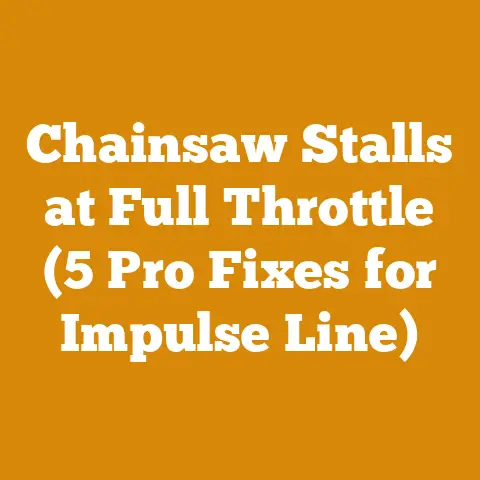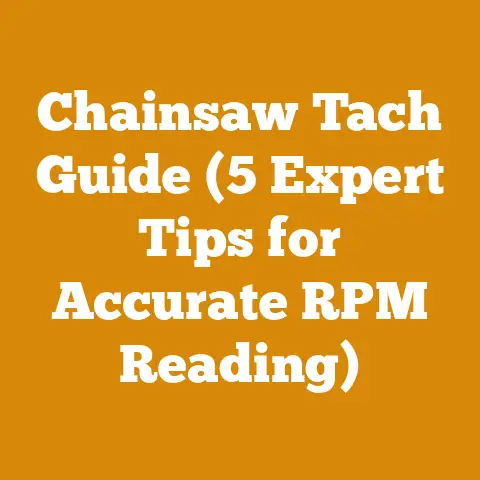MGM Trailers for Firewood Hauling (5 Expert Tips Inside)
I remember the first time I tried hauling firewood with a trailer that was clearly not up to the task. The axle groaned louder than my old chainsaw, and the whole thing felt like it would buckle under the weight of a few oak logs. That day, I learned a valuable lesson: the trailer you choose for hauling firewood is just as crucial as the chainsaw you use to cut it. It’s not just about having something to drag wood around; it’s about safety, efficiency, and protecting your equipment (and your back!).
This guide is all about MGM Trailers for firewood hauling. I’ll share my expertise, learned through years of experience and a few hard knocks, so you can make the right choice and haul your firewood safely and efficiently. I’ll dive deep into specifications, technical requirements, and practical tips, all geared towards helping you succeed, whether you’re a hobbyist, small logger, or firewood producer. Let’s get started!
MGM Trailers offers a range of options, but selecting the right one requires careful consideration. I’m going to give you five expert tips based on my experience to help you navigate the choices and make the best decision for your needs.
1. Understanding Your Hauling Needs: Volume, Wood Type, and Terrain
Before you even look at a trailer, you need to understand your specific hauling needs. This involves considering the volume of firewood you typically haul, the type of wood you’ll be handling, and the terrain you’ll be navigating.
-
Volume: How much firewood do you typically haul in a single trip? This will directly impact the trailer’s required load capacity. Firewood is typically measured in cords. A standard cord is 4 feet high, 4 feet wide, and 8 feet long (128 cubic feet). A “face cord” or “rick” is a stack 4 feet high, 8 feet long, but the width varies. Important Note: Always verify local legal definitions for cord measurements.
- Practical Example: If you’re primarily hauling seasoned hardwood like oak or maple, a full cord can weigh upwards of 4,000-5,000 pounds. Therefore, you’ll need a trailer with a higher GVWR (Gross Vehicle Weight Rating) than if you’re hauling a cord of lighter softwood like pine.
-
Wood Type: Different types of wood have different densities and weights. Hardwoods like oak, maple, and ash are significantly heavier than softwoods like pine, fir, and spruce.
- Data Point: Air-dried oak can weigh around 45-50 pounds per cubic foot, while air-dried pine might weigh only 25-30 pounds per cubic foot. This difference dramatically affects the total weight you’ll be hauling.
- Technical Specification: Wood density is directly related to its moisture content. Freshly cut “green” wood can be significantly heavier than seasoned wood due to the high water content.
-
Terrain: Consider the type of terrain you’ll be navigating. Will you be hauling firewood on paved roads, gravel driveways, or rough, off-road trails? This will influence the type of trailer suspension, tires, and overall construction you need.
- Personal Story: I once tried hauling a trailer loaded with oak logs across a muddy field with a standard-duty trailer. The trailer tires sank deep into the mud, and I nearly got stuck. Since then, I’ve learned the importance of having a trailer with adequate ground clearance and suitable tires for the terrain.
- Case Study: A local logging operation I consulted with was experiencing frequent trailer axle failures. After analyzing their operations, we determined that the trailers were being overloaded and subjected to excessive stress due to the rough terrain. We recommended upgrading to trailers with heavy-duty axles, reinforced frames, and off-road tires. This significantly reduced the number of breakdowns and improved their overall efficiency.
2. Matching Trailer Specifications to Load Requirements
Once you have a clear understanding of your hauling needs, you can start matching trailer specifications to those requirements. This is where understanding the technical details of MGM Trailers becomes crucial.
- Gross Vehicle Weight Rating (GVWR): This is the maximum permissible weight of the trailer, including the trailer itself and its load. Never exceed the GVWR. Exceeding the GVWR is dangerous and can damage the trailer, your towing vehicle, and potentially lead to accidents.
- Safety Code: The GVWR is typically listed on a sticker or plate attached to the trailer frame. Make sure you know the GVWR of your trailer before loading it with firewood.
-
Payload Capacity: This is the maximum weight of the load that the trailer can carry. It’s calculated by subtracting the trailer’s empty weight (also known as “tare weight”) from the GVWR.
- Formula: Payload Capacity = GVWR – Tare Weight
- Example: If a trailer has a GVWR of 7,000 pounds and a tare weight of 2,000 pounds, its payload capacity is 5,000 pounds.
- Axle Rating: The axle rating indicates the maximum weight that each axle can support. Make sure the axle rating is sufficient for the weight you’ll be hauling.
- Technical Requirement: For tandem-axle trailers, the total axle rating should be equal to or greater than the GVWR.
- Tire Rating: The tires on your trailer must be rated to handle the weight you’ll be hauling. Check the tire sidewall for the load rating (expressed as a number followed by a letter).
- Practical Tip: It’s always a good idea to choose tires with a load rating slightly higher than what you think you’ll need, just to be on the safe side.
- Trailer Size and Dimensions: Consider the size and dimensions of the trailer bed. Will it accommodate the length of firewood you typically haul? Make sure the trailer is long enough to prevent the firewood from hanging over the front or rear, which can be dangerous and illegal.
-
Deck Height: The deck height of the trailer affects the ease of loading and unloading firewood. A lower deck height makes it easier to load by hand, while a higher deck height may be necessary for navigating rough terrain.
-
Measurement: Measure the height of your truck bed or loading dock to determine the ideal deck height for your trailer.
3. Choosing the Right Trailer Type: Utility vs. Dedicated Firewood Trailers
MGM Trailers offers a variety of trailer types, each with its own advantages and disadvantages for hauling firewood. The two main categories are utility trailers and dedicated firewood trailers.
-
Utility Trailers: These are general-purpose trailers that can be used for a variety of hauling tasks, including hauling firewood. They are typically more affordable than dedicated firewood trailers, but they may not be as well-suited for the specific demands of firewood hauling.
- Pros: Versatile, affordable, readily available.
- Cons: May require modifications for firewood hauling, may not be as durable as dedicated trailers.
-
Dedicated Firewood Trailers: These trailers are specifically designed for hauling firewood. They typically feature reinforced frames, higher side walls, and other features that make them better suited for the task.
-
Pros: More durable, better suited for firewood hauling, often equipped with features like log racks and stake pockets.
- Cons: More expensive than utility trailers, less versatile.
Here’s a quick comparison table:
| Feature | Utility Trailer | Dedicated Firewood Trailer |
|---|---|---|
| Frame | Typically lighter-duty | Heavy-duty, reinforced |
| Side Walls | Lower, may require adding side boards | Higher, often with stake pockets |
| Suspension | Standard | Heavy-duty, designed for rough terrain |
| Price | Lower | Higher |
| Versatility | More versatile | Less versatile, primarily for firewood hauling |
| Durability | Less durable for heavy firewood loads | More durable, built for firewood hauling |
| Best For | Occasional firewood hauling, light loads | Frequent firewood hauling, heavy loads |
Modifying a Utility Trailer for Firewood Hauling
If you choose to use a utility trailer for hauling firewood, you may need to make some modifications to make it more suitable for the task. These modifications may include:
- Adding Side Boards: Adding side boards to the trailer increases the height of the side walls, which helps to contain the firewood and prevent it from falling off. Use sturdy materials like treated lumber or steel.
- Installing Stake Pockets: Stake pockets allow you to insert vertical stakes along the sides of the trailer, providing additional support for the load.
- Reinforcing the Frame: If you plan to haul heavy loads of firewood, you may need to reinforce the trailer frame to prevent it from bending or breaking. This can be done by welding additional steel supports to the frame.
4. Prioritizing Safety Features and Best Practices
Safety should always be your top priority when hauling firewood. This includes choosing a trailer with appropriate safety features and following best practices for loading, securing, and transporting the load.
- Brakes: Make sure the trailer is equipped with brakes if required by law. Most states require trailers with a GVWR over a certain weight (typically 3,000 pounds) to have brakes. Electric brakes are the most common type of trailer brakes.
- Technical Detail: Electric brakes require a brake controller in the towing vehicle. The brake controller sends a signal to the trailer brakes when the driver applies the brakes in the towing vehicle.
- Lights: Ensure all trailer lights are working properly, including the brake lights, turn signals, and running lights.
- Safety Regulation: Check your local regulations for specific requirements regarding trailer lights.
- Tie-Down Points: The trailer should have adequate tie-down points for securing the load. Use strong straps or chains to secure the firewood to the trailer.
- Best Practice: Use a criss-cross pattern when securing the load to prevent it from shifting during transport.
- Load Distribution: Distribute the load evenly across the trailer bed to prevent the trailer from swaying or becoming unstable. Place heavier logs towards the front of the trailer, over the axle.
- Data Point: Uneven load distribution can increase the risk of trailer sway by as much as 50%.
- Speed Limits: Obey all posted speed limits and drive defensively. Remember that a trailer will increase your stopping distance.
- Safety Tip: Reduce your speed when towing a trailer, especially on curves or in windy conditions.
- Regular Maintenance: Inspect your trailer regularly for any signs of damage or wear. Check the tires, brakes, lights, and hitch.
- Maintenance Schedule: Consult the trailer’s owner’s manual for recommended maintenance intervals.
- Personal Protective Equipment (PPE): Always wear appropriate PPE when loading and unloading firewood, including gloves, eye protection, and sturdy footwear.
- Tool Requirement: Use a log splitter or other mechanical device to split large logs to reduce the risk of injury.
5. Legal Considerations and Regulations
Before you start hauling firewood, it’s essential to be aware of any legal considerations and regulations that may apply. These regulations can vary depending on your location, so it’s always a good idea to check with your local authorities.
- Trailer Registration: Most states require trailers to be registered with the Department of Motor Vehicles (DMV).
- Trailer Inspections: Some states require trailers to undergo periodic safety inspections.
- Weight Limits: Be aware of any weight limits that may apply to the roads you’ll be traveling on.
- Load Securing Regulations: Many states have specific regulations regarding how loads must be secured on trailers.
- Permits: You may need a special permit to haul oversized or overweight loads.
- Commercial Regulations: If you’re hauling firewood for commercial purposes, you may be subject to additional regulations, such as commercial driver’s license (CDL) requirements.
- Environmental Regulations: Be aware of any environmental regulations that may apply to firewood harvesting or transportation. Some areas may have restrictions on the types of wood that can be harvested or transported to prevent the spread of invasive species or diseases.
- Example: Emerald Ash Borer quarantines restrict the movement of ash firewood in many areas.
Key Takeaways:
- Know your hauling needs: Volume, wood type, and terrain.
- Match trailer specifications to load requirements: GVWR, payload capacity, axle rating, tire rating.
- Choose the right trailer type: Utility vs. dedicated firewood trailers.
- Prioritize safety features and best practices: Brakes, lights, tie-down points, load distribution.
- Be aware of legal considerations and regulations: Registration, inspections, weight limits, load securing.






